Thursday, January 31, 2008
Wednesday, January 30, 2008
Goodbye, Columbus
A colleague in Columbus, Ohio, has alerted me to a local downturn. The city is planning to shrink its symphony orchestra into a chamber ensemble, abolishing 22 positions and cutting the concert season by half. That, they say, ought to wipe out an annual $1.5 million deficit.
"This is to try to save the orchestra and enable us to grow it into something special," said Robert "Buzz" Trafford, chairman of the symphony board, in a comment to the local newspaper which appears to endorse the move.
Hello? Come again? Anyone at home?
Surely no-one imagines that playing Haydn instead of Mahler is going to bring crowds banging on the doors, or that kicking musicians into limbo will improve morale in the band. Cutting an orchestra is usually one short step from killing it altogether.
Columbus, where I have never set foot, has (so I'm told) an appreciative, cultured audience who don't want to fly to Cleveland or Detroit for a symphonic experience. It also has a proud and supportive NPR station.
A city of 1.75 million can surely stump up a few donors to cover a $1.5 million hole. Slash and burn, which is what the board is proposing, is a policy that went out in the 90s with the bonfire of vanities. Someone needs to take a quick rethink and a look at the map.
Without a symphony orchestra, Columbus becomes a speck.
For more information, check www.symphonymusicians.com
source: Artsjournal
Tuesday, January 29, 2008
Monday, January 28, 2008
Philippe Quint : un « grand » du violon...
par Audrey Roncigli
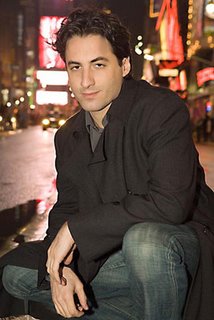 Le violoniste Philippe Quint, comme son nom ne l'indique pas, est né en Russie, et ses origines sont en Italie, dans la dynastie aristocratique des Quinti. Il est le descendant d'un officier de Napoléon, blessé en 1812, et qui émigra en Russie après avoir épousé une infirmière juive ! S'il porte un prénom français, c'est parce qu'il est le fils de Lora Kvint, chanteuse très populaire dans son pays, et qui était fascinée à l'heure de la naissance de Philippe par les familles royales françaises...Aujourd'hui citoyen américain et vivant à New-York, Philippe nourrit son jeu de ces histoires, de ces migrations et des diverses cultures dont il s'est imprégné.
Le violoniste Philippe Quint, comme son nom ne l'indique pas, est né en Russie, et ses origines sont en Italie, dans la dynastie aristocratique des Quinti. Il est le descendant d'un officier de Napoléon, blessé en 1812, et qui émigra en Russie après avoir épousé une infirmière juive ! S'il porte un prénom français, c'est parce qu'il est le fils de Lora Kvint, chanteuse très populaire dans son pays, et qui était fascinée à l'heure de la naissance de Philippe par les familles royales françaises...Aujourd'hui citoyen américain et vivant à New-York, Philippe nourrit son jeu de ces histoires, de ces migrations et des diverses cultures dont il s'est imprégné.
Philippe débute très jeune ses études musicales et rejoint l'Ecole Spéciale pour les Enfants prodiges de Moscou, où il a pour professeur Korsakov. À neuf ans, il donne son premier concert en soliste avec le Concerto N°2 de Wieniawski. À treize ans, il décide de s'engager dans la voie d'une carrière professionnelle, qui l'entraînera à la Juilliard School, dont il sortira en 1997 avec un baccalauréat et une maîtrise. Durant ces années d'études new-yorkaises, il suit l'enseignement de Dorothy DeLay, Felix Galimir, Isaac Stern, Itzhak Perlman, mais se définit une personnalité, un style propre : Philippe reconnaît ainsi que « le style et le jeu d'un violoniste sont d'abord définis par l'individualité, plus que par une quelconque allégeance particulière à une école ou à une autre ».
Poussé par le défi d'une musique qu'il ne connaissait pas, celle de son pays d'adoption, Philippe Quint découvre avec bonheur les oeuvres de Bernstein, Corigliano, Foss, Schuman, Copland. Un bonheur n'arrivant jamais seul, il décroche un contrat chez Naxos et commence à enregistrer : les Concertos pour violon de Schuman, Ned Rorem, la Sérénade de Bernstein qu'il affectionne tout particulièrement, les oeuvres pour violon et piano de Miklos Rozsa. Très prochainement sortira un enregistrement live du Concerto pour violon d'Erich Wolfgang Korngold et Philippe travaille à deux nouveaux albums : Corigliano/Thompson et Kreisler/Paganini.
Se forgeant une réputation de soliste charismatique, avec une technique hors pair et une justesse de ton et d'expression inégalée, Philippe parcourt le monde avec son Stradivarius de 1723, l'ex-Kiesewetter, qui lui est prêté par M. et Mme Arrisson de Buffalo. La liste des orchestres avec lesquels il a déjà joué est impressionnante : les orchestres de Détroit, Indianapolis, Minnesota, Bournemouth, Houston, Buffalo, Nashville ainsi que de la Virginie, de la Louisiane et de l'Oklahoma; le Royal Liverpool Philharmonic; l'Orchestre national de Chine; l'Orpheus Chamber Orchestra; l'Orchestre Symphonique de Bayonne Côte Basque; les orchestres de Pretoria, Cape Town et Johannesburg; les orchestres du Queensland et de Melbourne...sous la baguette de chefs tels que Marin Alsop, José Serebrier, Andrew Litton, Klauspeter Seibel, Kurt Masur, Hans Graf, Arild Remmereit, Maxim Shostakovich, JoAnn Falletta, Jorge Mester, Carlos Miguel Prieto et Kenneth Schermerhorn. Son répertoire s'étale de Vivaldi, Bach et Mozart à Bernstein, Chostakovitch et Piazzola, en passant par Beethoven, Brahms et Paganini. Son amie Lera Auerbach lui a dédié son Concerto n°1, qu'il a créé au Walt Disney Concert Hall de Los Angeles, et qu'il définit lui-même comme son « propre portrait musical ».
Les critiques louent son incomparable musicalité, son charisme hors norme, ses interprétations passionnées et techniquement parfaites. Que ce soit dans ses enregistrements ou sur scène, Philippe Quint fait de chaque pièce un moment de partage musical, vivant avec son public d'intenses moments d'émotion, dans la joie ou la tristesse, dans la douleur ou la frénésie...Nominé aux Grammy Awards, vainqueur de dizaines de compétitions dont le Concours Pablo de Sarasate en 1997, Philippe, que beaucoup de critiques appellent le « Paganini des temps modernes », est un violoniste qui captive ses auditoires à coup sûr.
Philippe est enfin un artiste très polyvalent, puisqu'il est aussi passionné de cinéma et acteur lui-même. Sportif et grand amateur d'échecs, Philippe avoue ne pas avoir assez de temps pour faire « tout ce dont il rêve ». Il n'en reste pas moins un violoniste simple et chaleureux, généreux et passionné. Ce qui fait la définition des « grands » artistes...
Audrey Roncigli : Dans quelle mesure pensez-vous que les éléments de votre vie personnelle ont influencé votre jeu et vos interprétations ?
Philippe Quint : Ayant grandi dans l'ex-Union Soviétique, je n'avais que très peu accès aux enregistrements considérés comme « tabou » dans le pays, comme ceux d'Heifetz, Milstein, Horowitz ou Rachmaninov, etc... Je parle bien entendu de tous ces artistes qui ont à un moment ou un autre quitté la Russie pour poursuivre leurs carrières et leurs vies ailleurs. Je me souviens très bien d'un jour où mon oncle rapporta « clandestinement » un enregistrement de Jascha Heifetz interprétant la Première Danse hongroise de Brahms; toute la famille se réunit pour écouter la performance exceptionnelle d'Heifetz. Pour beaucoup d'enfants en Russie, Heifetz fut certainement une sorte d'icône et une grande source d'inspiration. Cependant, après mon arrivée aux États-Unis en 1991, je fus rapidement « exposé » à une immense variété d'enregistrements, d'artistes, de musiciens, dans des perspectives très variées. Je dois bien avouer qu'au départ, cela m'a un peu dépassé et dans un sens, cela semait la confusion en moi. Mon monde s'écroulait à mesure et aussi soudainement que je réalisais qu'il y avait tant de possibilités d'approcher les compositions musicales. Je crois avoir acheté tous les enregistrements et vidéos disponibles de nombre de violonistes et les avoir écoutés et regardés des centaines de fois. Mon arrivée à New York a coïncidé avec mon entrée à la Juilliard School dans la classe de la légendaire Dorothy DeLay. Son approche était très différente de celle de mes anciens professeurs en Russie. Au lieu de crier et de jeter toutes sortes d'objets au-dessus de ma tête, elle disait tout simplement : « Mon petit chou, quelle est ta vision du fa dièse ? » Le résultat était tout aussi efficace que des cris ou des hurlements. Je me sentais vraiment mal à l'aise du fait qu'elle pense que mon fa dièse était faux et je travaillais encore plus dur pour être capable d'impressionner Mme DeLay à mon prochain cours. Elle était très certainement unique et je garde beaucoup d'excellents souvenirs d'elle. J'ai toujours un grand respect et une grande admiration pour elle.
Une autre rencontre très intéressante pour moi fut celle avec Isaac Stern, vers 1998 ou 1999. Il m'a dit quelque chose que je n'ai pas compris sur le coup, mais qui depuis a complètement changé ma vision de l'interprétation : « Philippe, tu dois comprendre qu'il y a une signification derrière chaque note. » Je ne comprenais pas comment cela était possible, mais après de nombreuses années passées à étudier et à jouer les oeuvres, je commence à comprendre ce que M. Stern essayait de me dire. Je suis tellement honoré de l'avoir rencontré et d'avoir joué pour lui.
Je vous ai cité ici seulement deux influences dans ma vie. J'aurais pu en citer des centaines, et si j'avais commencé, nous aurions dû écrire un livre, un article n'aurait pas suffi !
Audrey Roncigli : Vous avez consacré une large part de votre répertoire à la musique américaine. Pourquoi cette passion particulière pour des compositeurs comme Foss, Rorem, Corigliano ?
Philippe Quint : Ayant grandi en URSS, je connaissais les grands « standards » du répertoire, Bach, Mozart, Beethoven, Brahms, Franck, Tchaïkovski et les autres. Rappelez-vous que nous étions en période de « guerre froide » et le mot « Américain » ne devait pas être prononcé à voix haute. Il me semble que le seul compositeur américain connu à cette époque en Russie était Gershwin et son Porgy and Bess. Ma première « rencontre réelle » avec la musique américaine a eu lieu lorsque je suis arrivé aux États-Unis et que j'ai entendu West Side Story. Les années qui ont suivi, j'ai appris de nombreuses pièces de musique américaine, de Copland à Cage, de Cowell à la jeune génération comme Corigliano, Ned Rorem ou William Bolcom.
Je me suis beaucoup intéressé à la musique américaine car les harmonies et les structures rythmiques m'intriguaient beaucoup et c'était une chose totalement nouvelle pour moi.
Ma première oeuvre fut la Sonate pour violon de John Corigliano, une oeuvre fascinante que je viens d'enregistrer. J'ai eu ensuite le privilège de travailler avec Lukas Foss et nous avons enregistré ses pièces pour violon et piano. Puis ont suivi des projets pour Naxos, dans la collection American Classics, dont le Concerto pour violon de William Schuman (une oeuvre merveilleuse et très sous-estimée), la Sérénade de Bernstein et le Concerto de Ned Rorem. Rorem et Schuman sous la baguette du chef d'orchestre José Serebrier.
On me demande souvent pourquoi je joue autant de musique contemporaine et de musique américaine. Je réponds : « Pourquoi pas ? » Bien entendu, les gens aiment entendre Mozart et Mendelssohn, mais on ne peut pas vivre en dehors de son siècle et ne jouer que les compositeurs du passé. Il y a tant de merveilleux compositeurs aujourd'hui et je me réjouis de découvrir de nouvelles pièces de nos contemporains.
Audrey Roncigli : On vous compare très souvent à Paganini. Que cela vous inspire-t-il et comment réagissez-vous ?
Philippe Quint : (Rires) Je mets au défi quiconque de me dire comment il jouait ! C'est plutôt une comparaison amusante. Je ne sais pas trop d'où elle provient. Peut-être de mon apparence physique : je suis grand, avec de longs bras et des cheveux noirs...Les gens aiment comparer les violonistes du présent avec ceux du passé, en donnant une sorte de qualification, telle que « le prochain Menuhin », ou « le prochain Oïstrakh ». Ces comparaisons sont flatteuses, bien entendu, mais il est important de comprendre qu'on ne demande pas de trouver le prochain X ou Y. Il me semble qu'il est plus important de découvrir de nouveaux talents plutôt que d'avoir sur scène de pâles imitations d'un musicien du passé. Une de mes récentes influences est Gidon Kremer, qui est un vrai intellectuel et un musicien fantastique, tout en étant anticonformiste dans ses interprétations, toujours capable de trouver des nouveautés, des innovations dans des oeuvres que l'on entend depuis des dizaines et des dizaines d'années.
Je lui porte un grand respect et une grande admiration. Ce n'est pas quelqu'un qui essaie d'être différent pour être différent, mais il poursuit ses choix musicaux intensément et ne s'en écarte jamais.
Pour en revenir à Paganini...J'envisage de l'étudier très en détail et en fait, l'un de mes prochains enregistrements sera consacré à ses oeuvres pour violon et piano arrangées par Fritz Kreisler. La musique de Paganini a été très souvent critiquée, pour sa « substance ». J'ai une opinion tout à fait différente : je pense qu'on doit considérer ses oeuvres comme une sorte de petite opérette italienne, le violon tenant la partie principale. Le violon « bel canto » en quelque sorte !
Audrey Roncigli : Quelles ont été, ces derniers mois, les pièces qui vous ont été les plus difficiles à interpréter, et celles qui vous ont le plus enthousiasmé ?
Philippe Quint : Je pense que les oeuvres les plus difficiles sont celles qui vous demandent beaucoup sur le plan émotionnel. L'une de ces pièces est bien entendu le Concerto n°1 de Chostakovitch. Après une Passacaglia très intense en émotions, vous passez tout de suite à une Cadenza diaboliquement difficile...Il n'est pas étonnant que David Oïstrakh ait demandé à Chostakovitch de placer un petit tutti d'orchestre avant le début du quatrième mouvement, afin que le violoniste puisse respirer un peu avant de replonger dans quelque chose de plus trouble, de plus sombre. Cette pièce est très difficile, car elle ravive en moi des souvenirs de mon enfance en Russie.
Vous savez, la description que Chostakovitch fait de la Russie est exactement la mienne : « Quand je regarde mon passé, tout me semble gris. » C'est très intéressant et cela associe chez moi la Russie à la couleur grise. Son premier mouvement, très subtil et intense, est peut-être une indication de ce « gris » dont il parle.
Je pense que les oeuvres que je considère comme les plus difficiles sont aussi mes préférées : le Concerto et les Sonates de Beethoven, les Concertos de Brahms, Sibelius, de Stravinsky, et quelques autres...J'apprécie ce qu'on appelle la « musique programme », la musique étant basée sur une histoire : la Sérénade de Bernstein me vient immédiatement à l'esprit. Mais même si la musique n'est pas toujours accompagnée d'une histoire, je m'en crée une ! C'est plutôt simple et cela aide l'interprétation.
Audrey Roncigli : Vous êtes un vrai globe-trotter, entre l'Australie, l'Afrique, l'Europe et les États-Unis. Pouvez-vous nous donner un aperçu de votre saison 2008 ?
Philippe Quint : Les six derniers mois ont été très intenses. J'ai réussi à jouer en Australie, en Amérique du Nord, du Sud, en Afrique du Sud et en Europe en moins de six mois ! C'était excitant et fascinant de visiter tous ces merveilleux endroits, mais très fatigant également. J'espère avoir un emploi du temps un peu plus « bénéfique » ces prochaines années. Parmi les grands moments de la saison à venir, mes débuts en Allemagne avec la Staatskapelle de Weimar sous la direction de Carl St Clair. Je ne peux pas ne pas citer la sortie de mon album Korngold sous la baguette de mon ami de longue date Carlos Miguel Prieto. Il y aura aussi le premier enregistrement mondial des Caprices du Violon rouge de Corigliano et sa Sonate, couplés avec des pièces de Virgil Thomson, pour Naxos. Deux CD de musique américaine, encore !
Et aussi...un récital à Montréal en octobre prochain !
Visitez le site web de Philippe Quint
Critique de disque : Miklós Rózsa: Music for Violin and Piano
Crédit photographique : © Pavel Antonov
Gala des prix Opus 2006-2007
Sans grande surprise, le prix de l'Événement musical de l'année fut remporté par l'Orchestre symphonique de Montréal, pour le concert d'ouverture du 6 septembre 2006 dirigé par Kent Nagano. Ce concert, projeté en direct de la salle Wilfrid-Pelletier et de l'esplanade de la Place des Arts, avait attiré quelques centaines de milliers d'auditeurs via le site Internet, la télévision, la Première Chaîne de la radio de Radio-Canada et Espace musique.
Le prix d'Interprète de l'année fut remis à l'ensemble Les Voix humaines, et le jury a sélectionné le compositeur et électroacousticien montréalais Serge Arcuri comme Compositeur de l'année. L'exceptionnelle saison du 30e anniversaire du Festival de Lanaudière fut soulignée par le prix Diffuseur de l'année. La soprano Marianne Fiset a obtenu le prix Découverte de l'année, prix qui fut par le passé accordé à des artistes tels que Yannick Nézet-Séguin, Marie-Nicole Lemieux et le Quatuor Molinari.
Par ailleurs, le Conseil québécois de la musique soulignait cette année la carrière du musicien Otto Joachim, récipiendaire du prix Hommage. Davis Joachim, fils du compositeur émérite, interpréta avec simplicité une ¦uvre pour guitare de son père et le critique musical Claude Gingras prononça un bref discours en l'honneur de son ami de longue date. Déplorant de se retrouver sur scène plutôt que dans l'assistance, l'intransigeant critique du journal La Presse provoqua de francs éclats de rire en s'exclamant, plissant des yeux sous l'intensité des projecteurs, « C'est ça, être artiste? » et cherchant le compositeur dans la salle obscure, afin de pouvoir le féliciter directement : « Wo bist du, Otto ? »
Parmi les moments forts du gala, mentionnons l'interprétation virtuose que donna le Quatuor Molinari du périlleux deuxième mouvement du Quatuor à cordes no 2 d'Alfred Schnittke et la surprenante prestation multimédia d'Espaces Sonores Illimités, intitulée Spatio-Lumino. L'exécution d'une ¦uvre pour percussions d'Iannis Xenakis par l'ensemble Sixtrum fut également très appréciée.
> La liste des lauréates.
Sunday, January 27, 2008
Pierre de La Rue : The Complete Magnificats, 3 Salve Reginas
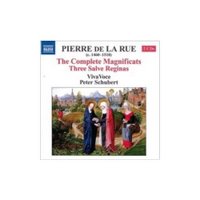 Peter Schubert, Viva Voce
Peter Schubert, Viva VoceNaxos 8.557896-97 (119 min 53 s)
***** $$
Ce disque est exceptionnel pour deux raisons. D'abord, il nous offre le premier enregistrement complet des remarquables Magnificats de Pierre de La Rue (1460-1518). Deuxièmement, il nous donne la chance d'entendre Peter Schubert et son ensemble Viva Voce s'exprimer avec une splendeur qui ne peut que les inscrire dans la lignée des grands ensembles vocaux spécialisés en musique ancienne. Le style de La Rue est à la croisée de l'ancien et du nouveau. Il utilise aussi bien les techniques, déjà éprouvées, de la 1re moitié du 15e siècle que les nouvelles méthodes apparues dans la 2e. Chez de La Rue, les mélismes mélodiques du cantus firmus cohabitent intelligemment avec la nouvelle rigueur imposée à la relation entre structure syllabique et développement motivique. Ce coffret double est un délice pour tous les amoureux de polyphonie. De plus, il permettra à l'un de nos fleurons musicaux de rayonner aux quatre coins de la planète.
-Frédéric Cardin
Buy this CD at amazon.com
Labels: french, product_review, vivavoce
Saturday, January 26, 2008
Canadian Heritage Proposes Merger of CMF and PAP
Of note to the Arts and Literature community, according to a post on the Canadian Magazines blog, the proposal will eliminate the $1 million Support for Arts and Literary Magazines.
Also of interest are two aspects of the proposal:
The first item seems to open the door for predominately controlled circulation arts and literary magazines such as The Music Scene Ontario and La Scena Musicale to regain funding. Recall that in 2003, the CMF cut off funding to controlled circulation magazines when it reduced its budget by half, affecting several arts titles including La Scena Musicale.Business flexibility for publishers: Canada Post's decision to withdraw from the PAP offers the opportunity to open funding to other methods of distribution, thereby putting more strategic control in the hands of publishers.
Transitions to digital technology: The proposed approach offers opportunities to address changes in the way Canadians are consuming news and entertainment: through joint initiatives on industry-wide projects and by exploring the possibility of opening funding to new forms of publications or to online content produced by print publications.
To participate in the consultation, DCH has issued 10 questions for discussion.
The deadline for submissions is April 25, 2008.
Discussions on other blogs:
> Canadian Magazines
> The Shoestring
> Masthead Online [subscription required]
Labels: funding, magazines, publishing
Today's Musician Birthday: January 25
Friday, January 25, 2008
Prokofiev Orchestral Works
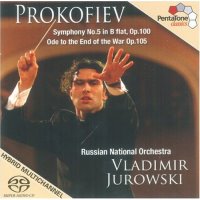 Symphony No. 5/Ode to the End of the War
Symphony No. 5/Ode to the End of the WarRussian National Orchestra
Vladimir Jurowski, dir.
Pentatone Classics PTC 5186 083 (57 m 7 s)
***** $$$$
Once again, chalk one up for the young guns: the new generation of conductors is truly yielding some remarkable talents. Russian Vladimir Jurowski, 35, has become a household name in
-Graham Lord
Labels: jurowski, product_review, prokofiev
Don Carlos
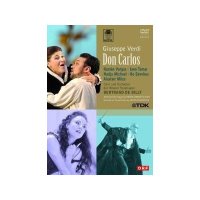 Ramon Vargas, Iano Tamar, Nadja Michael, Bo Skovhus, Alastair Miles
Ramon Vargas, Iano Tamar, Nadja Michael, Bo Skovhus, Alastair MilesOrchestra and Chorus of Wiener Staatsoper, Bertrand De Billy, dir.
TDK DVWW-OPCARLOS (2 DVDs, 4h 7m)
*** $$$$$
Verdi originally conceived Don Carlos as a French Grand Opera in five acts plus ballet. It premiered at the Paris Opera in March 1867. In 1866, Verdi had already made a number of cuts because of its length, and further cuts were authorized during rehearsals. These included parts of Act One and several extended duets of the principals. This being a Grand Opera, the ballet was retained. Therefore, this monumental work was not performed in its complete form for the premiere. An Italian translation, with further changes, was first performed as Don Carlo later at
So for Don Carlos purists, this is the version to get - or is it? Originally conceived by Peter Konwitschny for
It is a shame that the stage direction hijacked an essentially fine performance. The orchestra under the stylish baton of Bertrand de Billy sounds great. Honours go to Ramon Vargas as a vocally impeccable Carlos. Bass Alistair Miles has all the stately bearing necessary for Philip. The other principals are also quite good. Georgian soprano Iano Tamar impresses with her dark, rich voice, lacking only the necessary high piano. Soprano Nadja Michael pushes her slender voice fearlessly as a glamorous Eboli - her timbre in this mezzo role is lighter than
-Joseph K. So
Labels: don_carlos, opera, product_review, verdi
Grieg : Peer Gynt Suites, Six Orchestral Songs
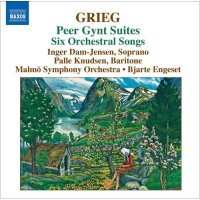 Malmö Symphony Orchestra; Bjarte Engeset, dir.
Malmö Symphony Orchestra; Bjarte Engeset, dir.Inger Dam-Jensen, soprano, Palle Knudsen, baryton
*** $
On trouvera ailleurs des interprétations plus inspirées des deux Suites tirées de la musique pour scène de Peer Gynt. Sous la baguette d'Engerset, les mélodies s'affadissent et l'atmosphère de légende indispensable, faite de nostalgie et de poésie rêveuse, mais aussi d'une sorte de tendre ironie, n'est guère au rendez-vous. Tout cela finit par ressembler à de la musique de village. Le programme vaut beaucoup plus par les oeuvres chantées qui suivent. Le baryton Palle Knudsen sait mettre en valeur le premier lied tiré de l'opus 21 de Grieg, Quatre Poèmes de la Fille du pêcheur de Bjørnson, et surtout la ballade populaire du Prisonnier de la montagne op. 32 où l'art du compositeur norvégien pour suggérer l'univers nordique est au mieux. La soprano Dam-Jensen, malgré une voix assez belle, convainc moins dans les Six Chants orchestraux EG 177 que Grieg a réunis à partir de diverses oeuvres; on y retrouve entre autres la célèbre Chanson de Solveig et la Berceuse de Solveig tirés de Peer Gynt.
-Alexandre Lazaridès
Labels: french, grieg, product_review
Die Zauberflöte
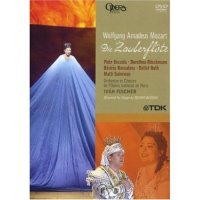 Piotr Beczala (Tamino), Dorothea Röschmann (Pamina), Detlef Roth (Papageno), Matti Salminen (Sarastro), Désirée Rancatore (Reine de la Nuit), Gaële Le Roi (Papagena), Uwe Peper (Monastatos)
Piotr Beczala (Tamino), Dorothea Röschmann (Pamina), Detlef Roth (Papageno), Matti Salminen (Sarastro), Désirée Rancatore (Reine de la Nuit), Gaële Le Roi (Papagena), Uwe Peper (Monastatos)Orchestre et Choeurs de l'Opéra national de Paris; Ivan Fischer, dir.
Mise en scène : Benno Besson
TDK DVWW-OPMFP (158 min)
*****$$$$
Une Flûte enchantée...enchanteresse ! On n'a pas assez d'yeux pour apprécier toute la richesse des costumes, toutes les effervescences scéniques. En un tour de main, peut apparaître une jungle luxuriante peuplée d'animaux sauvages. Une autre fois, c'est la Reine de la Nuit qui surgit du sol et s'envole dans les airs, habillée d'une robe démesurée qui meuble toute la scène. Il y a plein de ces trouvailles visuelles qui tiennent de la magie. Côté chant aussi, nous sommes choyés. Le personnage de Pamina est très bien rendu par Röschmann, une mozartienne accomplie - on se remémorera avec plaisir sa Susanna des Noces de Figaro (DVD Arthaus 100 017). Roth insuffle dynamisme et justesse vocale à son Papageno. Rancatore interprète à merveille le fameux air Der Hölle Rache kocht in meinem Herzen. Salminen, avec sa superbe voix de basse, brille là comme il le fait dans tant d'autres productions DVD...Question mise en scène et tournage, la référence absolue pour cet opéra demeure l'adaptation d'Ingmar Bergman, de 1975 (DVD Criterion 71), mais le célèbre cinéaste n'avait pas la contrainte du direct, et ses chanteurs - crime de lèse-majesté - s'exprimaient en suédois.
-Pierre Demers
Labels: dvd, french, magic_flute, mozart, opera, product_review
Jupiter String Quartet: Shostakovich and Britten
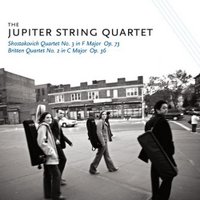 Shostakovich Quartet No. 3
Shostakovich Quartet No. 3Britten String Quartet No. 2
Marquis Classics MAR 371 (65 m 55 s)
**** $$$
The Jupiter String Quartet is, on paper, a blue-chip young group with all the right credentials to succeed in this remarkably competitive business of chamber music. This release, its début CD, comes on the heels of a host of prizes and honours: first prize at the 2004 Banff International String Quartet Competition, the Grand Prize at the Fischoff National Chamber Music Competition of the same year, winners of the 2005 Young Concert Artists International Audition, and selection for a residency at
-Graham Lord
Labels: britten, jupiter_quartet, product_review, shostakovich
Fernandes, Freitas Branco
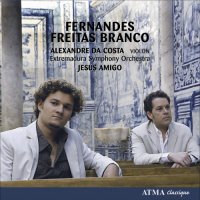 Extramadura Symphony Orchestra; Jesús Amigo, dir.
Extramadura Symphony Orchestra; Jesús Amigo, dir.Alexandre Da Costa, violon
Atma classique ACD2 2578 (73 min 45 s)
*** $$$
Il y a deux ans, le même ensemble et le violoniste montréalais Da Costa avaient donné une interprétation des plus intéressantes du Concerto pour violon de Luis de Freitas Branco. Le présent enregistrement de la Symphonie no 2 en si bémol mineur (1926) ne se situe pas à la même hauteur. L'oeuvre se laisse écouter, mais elle fourmille de réminiscences de l'idiome symphonique post-romantique (Brahms, Tchaïkovski, Sibelius...) qui dénotent plus de savoir-faire que d'originalité. Le meilleur moment est sans doute le troisième mouvement, une sorte de scherzo délicatement orchestré, mais la coda du dernier mouvement sombre dans le pompiérisme. À quoi il faut ajouter que l'orchestre sonne bien mollement tout au long. Quant au Concerto (1948) de Armando José Fernandes, sans charme ni intérêt, on se demande s'il était nécessaire de l'exhumer tant le prosaïsme de l'écriture et le statisme sont patents. Da Costa lui-même ne semble pas trop y croire, le chef non plus.
-Alexandre Lazaridès
Labels: da_costa, french, product_review
Thursday, January 24, 2008
Met Cancels Opera Pay-Per-View On-Demand
> Metropolitan Opera Live in HD"There was this real outcry from the movie theaters," said Peter Gelb, the Met's general manager. "We were not aware they were going to feel this way until we announced we were doing this." He added: "We are not a movie. We're a live transmission."
Under agreements with major Hollywood studios movies usually take much longer to reach on-demand services. Mr. Gelb said the theater operators might have worried about alienating the studios by allowing a shorter lag. He said he hoped to start the on-demand showings next season, for which the schedule of opera transmissions has not yet been made.
> Stories about HD Opera
Labels: HD, Metropolitan Opera, opera
Wednesday, January 23, 2008
Viva Villazón!
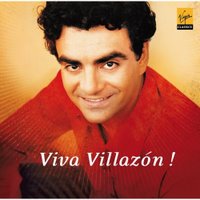 Best of Rolando Villazón (CD; 57 m 30 s)
Best of Rolando Villazón (CD; 57 m 30 s)Live in
Virgin Classics 504762-20
***** $$$
If you are new to the art of Mexican tenor Rolando Villazón, this combination CD-DVD set is the one to buy. The CD contains selections from all the recital discs he made when under contract to EMI/Virgin Classics. While the 35-year-old singer is still very much in his vocal prime, his hectic schedule and a tendency to give unstintingly have taken a toll on his voice, at least temporarily. A certain unreliability has crept into his singing, resulting in a 6-month hiatus in the latter part of 2007. (He resumed performing this January, as Werther at the Vienna State Opera, to cautiously good reviews). His Virgin Classics output dates from 2004-6, when his voice was in pristine shape. His Italian opera arias disc - my personal favourite - was recorded in 2004 with the late Marcello Viotti. Everything is sung with gorgeous tone, rock-solid technique and his trademark sense of drama. His ingratiating, darkish timbre recalls a young Plácido Domingo; his liberal use of mezza voce is an unalloyed pleasure. Also in this potpourri is the French album from a year later with Evelino Pidò, and a marvellous third disc of mixed repertoire under the baton of Michel Plasson. Everything has been previously issued except for "Donna non vidi mai" from Manon Lescaut, the Puccini Des Grieux role he has yet to sing onstage.
However beautiful Villazón's voice is, a substantial part of his magic is visual. A charming and irrepressible personality onstage and off, Villazón exudes an unbridled joy of singing that is infectious. You can get a glimpse of it in the concert from
-Joseph K. So
Labels: opera, product_review, villazon
Handel Water Music
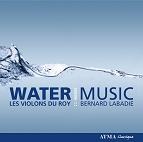 Les Violons du Roy
Les Violons du RoyBernard Labadie, dir.
ATMA Classique ACD2 2569
****** $$
Les trois suites pour orchestre qui composent la Water Music de George Frideric Handel font partie de ces pièces qui, par le génie de leur construction et l'énergie irrésistible qui s'en dégage, connaissent une popularité qui ne s'est jamais essoufflée depuis sa création. La quantité énorme de versions endisquées en fait foi. On en trouve de toutes les sortes et pour tous les goûts : instruments d'époque ou modernes, grand ensemble ou orchestre de chambre, esthétique baroque ou romantique, etc.
Handel, nouvellement arrivé en Angleterre, reçoit en 1717 une commande particulière : on lui demande de la musique festive, devant être jouée sur la Tamise à l'occasion d'un trajet nocturne du roi George 1er entre Whitehall et Chelsea. Le compositeur concocte alors un amalgame de pièces nouvelles et anciennes, qu'il groupe en trois suites de tonalités différentes; elles constituent de bons exemples de suite pour orchestre, genre dont la forme n'était pas fixée à l'époque. On y trouve une ouverture d'inspiration française, diverses danses et des mouvements lents. Handel fait appel, en plus des cordes, à des instruments à vent pouvant être entendus à grande distance, notamment des hautbois, des cors et des trompettes. Des comptes rendus de l'époque indiquent que le roi a tellement aimé l'oeuvre qu'il demanda aux musiciens de la rejouer entièrement deux autres fois le même soir !
Cette version des fameuses suites de la Water Music s'avère, un véritable coup de coeur dès les premières secondes d'écoute. Pour cette nouvelle collaboration entre les Violons du Roy et Atma classique, l'ensemble de Québec revient au répertoire baroque qui est sa spécialité. Les Violons, en alliant une interprétation stylistiquement rigoureuse à la perfection de son des instruments modernes, parviennent encore une fois à des sommets d'inspiration et de vitalité. Son ensemble a beau être relativement restreint (28 musiciens), Labadie en tire une fougue absolument incroyable ! Les bois nous offrent des solos inspirés, les cuivres sont retentissants, les cordes nerveuses et inspirées. Voici certainement un ensemble dont la capitale peut être fière. Cet enregistrement, qui propose également deux extraits de l'oratorio Solomon, est le tout premier réalisé dans la nouvelle salle Raoul-Jobin du Palais-Montcalm, un lieu à l'acoustique vivante qui convient parfaitement à cette musique composée pour les grands espaces.
-Louis-Pierre Bergeron
Labels: french, handel, product_review, violons_du_roy
Tango Notturno
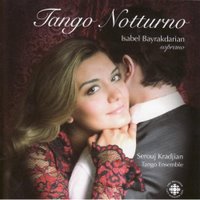 Isabel Bayrakdarian, soprano, Serouj Kradjian, piano; Fabian Carbone, bandoneon; Marie Berard, violin; Roman Borys, cello; Roberto Occhipinti, bass; Shalom Bard, clarinet; Daiel Bolshoy, guitar; Levon Ichkhanian, oud
Isabel Bayrakdarian, soprano, Serouj Kradjian, piano; Fabian Carbone, bandoneon; Marie Berard, violin; Roman Borys, cello; Roberto Occhipinti, bass; Shalom Bard, clarinet; Daiel Bolshoy, guitar; Levon Ichkhanian, oudCBC Records MVCD 1176 (70 m 15 s)
***** $$$
Arguably more than any other musical genre, the tango epitomizes romance - or should I say desire - in all its varieties. Though Latin in origin, tango is really an international genre, as this CD amply demonstrates. Prominently featured are of course the magical pieces by the famous Argentinean tango masters Carlos Gardel and Astor Piazolla. But equally important are the works by Danish, German, Egyptian and Armenian composers featured on this disc. In fact, one of the most popular of all tango melodies, "Jalousie", was written by Jacob Gade, a Dane; and the more adventurous minded should seek out a highly enjoyable disc sung by, of all people, the great basso profundo Matti Salminen in a delicious selections of Finnish tango music!
This new disc from CBC Records stars soprano Isabel Bayrakdarian. Her affinity to the Latin genre is well known, witness her Azulao disc on CBC, and in particular her lovely interpretation of Villas-Lobos' Bachianas brasileiras No. 5. While her lyric instrument is a departure from what one is used to hearing in these sultry songs, Bayrakdarian's stylish singing here is a marvel. She combines a beautiful voice, solid technique, innate musicality, not to mention immaculate diction and great attention to textual nuance. A true vocal chameleon, one is struck by the variety of timbres and accents she employs, from an innocently girlish sound in some of the pieces to a highly dramatic and world-weary timbre in Piazolla's "Rinacerò", the last selection on the disc. She is beautifully supported by the Tango Ensemble on this recording, led by the collaborative piano of Bayrakdarian's husband, Serouj Kradjian, an accomplished pianist in his own right. Playing no small part is the idiomatic bandoneón of Fabián Carbone. Also deserving of mention is Canadian Opera Company concertmaster Marie Bérard, for her lovely violin solo in "Jalousie". Kudos to the CBC engineers for a most atmospheric recording, a few overdone reverbs notwithstanding. On balance, this disc has my vote as the best "World Music" album by a Canadian classical artist in 2007.
-Joseph K. So
Labels: bayrakdarian, cbc, product_review, tango
Franz Schubert : Die Winterreise (version de chambre de Normand Forget)
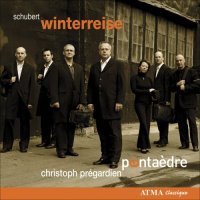 Pentaèdre, Christoph Prégardien, ténor et Joseph Petric, accordéon
Pentaèdre, Christoph Prégardien, ténor et Joseph Petric, accordéonATMA classique ACD2 2546
***** $$$
On considère souvent Die Winterreise comme étant la quintessence du cycle de lieder; une quantité innombrable de ténors et de barytons ont gravé leur interprétation, notamment Dieter Fischer-Dieskau, Peter Pears et, plus récemment, Ian Bostridge.
Le Voyage d'hiver est une des dernières oeuvres de Schubert. Écrite en 1827 au moment où il sent avec désespoir sa santé décliner, le compositeur y exprime ses plus sombres pensées sur l'amour impossible et la fatalité de la mort. La lecture d'un recueil de poèmes de son contemporain Wilhelm Müller l'interpelle profondément. Müller y raconte, en 24 tableaux, l'histoire d'un jeune homme qui, abandonné à la suite d'un échec amoureux, se lance dans un voyage sans retour à travers la campagne gelée. Schubert venait de trouver un souffle avec lequel il pourrait sublimer ses pensées lugubres et atteindre de nouveaux niveaux d'émotion, de profondeur.
La présente version, pour voix d'homme accompagnée d'un quintette à vents et d'un accordéon, est exceptionnelle à tous points de vue. Normand Forget, le hautboïste de Pentaèdre, a préparé un arrangement raffiné qui non seulement remplace la partie de piano originale, mais la pousse plus loin en colorant les atmosphères. La partition fait appel à des instruments secondaires (piccolo, hautbois d'amour, clarinette basse, etc.). Le quintette se transforme même en choeur sans paroles pour un des lieder ! Notons que Forget a gardé l'ordre initial des poèmes et non celui du cycle de Schubert.
Avec cet enregistrement, le ténor allemand Christoph Prégardien confirme sa place parmi les grands chanteurs de lieder actuels; sa voix, dont on ne perd pas un seul mot, est tour à tour plaintive, puissante et rêveuse, toujours ronde et contrôlée à l'aigu comme au grave. L'inspiration est continue et la complicité avec Pentaèdre, palpable. Le quintette à vents, complété du formidable accordéon de Joseph Petric, produit un accompagnement d'une extrême beauté.
Pentaèdre, un peu à la manière du Kronos Quartet, réussit à se renouveler constamment; la formation transcende le genre du quintette à vents. Avec quel nouveau projet va-t-il nous surprendre ?
-Louis-Pierre Bergeron
Labels: forget, french, product_review, schubert, winterreise
Domenico Cimarosa Ouvertures, vol. 2
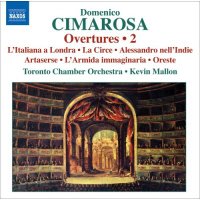
Kevin Mallon, dir.
Naxos
****** $
Dès quelque 65 opéras que Cimarosa (1749-1801) a composés, seulement un ou deux se maintiennent aux confins du répertoire. Pourtant, chaque fois qu'on a l'excellente idée de tirer de l'oubli un de ses autres ouvrages, instrumental ou vocal, le résultat est toujours heureux, comme en témoigne avec abondance une discographie de plus en plus fournie et constituée en bonne partie d'intégrales d'opéras, opere serie et surtout opere buffe. C'est par ce biais que l'on connaissait déjà plusieurs des ouvertures (L'Italiana a Londra, L'Armida immaginaria, etc.) qui composent le programme de ce CD, les autres étant, sauf erreur, des premières parutions au disque. La plupart de ces partitions sont exécutées ici d'après les éditions critiques récentes réalisées par le musicologue néo-zélandais Allan Badley (cosignataire des notes d'accompagnement) et publiées par la firme italienne Artaria. Cimarosa s'y révèle sinon un génie, du moins un très grand maître en pleine possession de tous les moyens de son art et dont le style noble et élégant, très proche de celui de Mozart - moments d'extase et zones d'ombre en moins - se caractérise par une inventivité et un raffinement mélodiques et orchestraux hors du commun, même au siècle des Lumières. C'est donc avec impatience que l'on attendra la suite de cette magnifique série !
-Pierre Marc Bellemare
Labels: cimarosa, french, product_review
Le barbier de Séville en CD et DVD : Repères discographiques
Si vous n'êtes pas un admirateur de Callas, vous préférerez sans doute la version Abbado (1972) sur Deutsche Grammophon, un autre enregisrement studio qui jouit d'un prestige presque aussi grand et qui domine aussi la discographie DVD car il existe également en vidéo. Cet enregistrement qui, 35 ans après, demeure disponible dans les deux médias (vidéo : 000427909; audio 457733) à des prix très avantageux, met en vedette Teresa Berganza (Rosine), Hermann Prey (Figaro), Luigi Alva (encore !) en Almaviva, Paolo Montarsolo (Basilio) et Enzo Dara (Bartolo) - une distribution très solide, en dépit de faiblesses mineures. Berganza est aussi délicieusement malicieuse à sa façon que l'était Callas et elle présente l'avantage comparatif d'être une véritable mezzo (et quelle mezzo !), tandis qu'Enzo Dara se classe d'emblée dans l'élite des clowns chantants qui, au fil des ans, se sont illustrés dans le rôle de Bartolo. Par contre, le Figaro d'Hermann Prey est un peu trop posé, trop classique, pour ne pas dire mozartien.
Quant à la version DVD, qui relève de l'opéra filmé, on l'aimera un peu, plutôt, beaucoup, ou énormément, selon sa réaction à l'humour visuel du metteur en scène Jean-Pierre Ponnelle. Celui-ci est très, très inventif, même un peu trop au goût de certains, notamment dans le finale du premier acte, où la farce tend à l'emporter sur la comédie.
Le nombre de versions DVD du Barbier actuellement disponibles ou qui l'étaient encore récemment frise la douzaine, dont une production scénique de Dario Fo (Image Entertainment, épuisé) qui déroutera les uns et charmera les autres, une vieille production télévisuelle en allemand avec Wunderlich en Almaviva et...Hans Hotter en Basilio (Deutsche Grammophon, 000577509), un écho du Festival de Glyndebourne de 1982, où la jeune Maria Ewing triomphe en fausse ingénue (Kultur, 2101), et plusieurs autres, dont aucune, cependant, ne parvient à remettre en question l'hégémonie, pourtant souvent contestée, de la version Abbado/Ponnelle.
Labels: barber_of_seville, french, product_review, rossini
Wilhelm Friedemann Bach - Oeuvres pour clavier, vol. 1
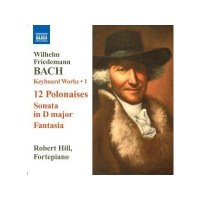
Robert Hill, fortepiano
Naxos 8.556966 (64 min 21 s)
****** $
Wilhelm Friedemann Bach (1710-1784), l'aîné des fils du grand Jean-Sébastien, était un singulier personnage dont la vie personnelle et la carrière professionnelle furent un désastre, une interminable descente dans l'alcoolisme et la misère. Quant à sa production artistique, aux antipodes de celle de son père, elle est l'oeuvre d'un génie, rebelle à toute règle. C'est une musique étrange qui, par (d'assez) longs moments, donne l'impression d'avoir été composée un siècle, voire deux, après l'époque où a vécu le musicien. Les plus fascinantes de ces partitions sont celles qu'il a écrites pour les claviers, car ceux-ci lui permettaient de s'exprimer, en toute liberté, à travers des formes qui n'en étaient guère, comme la polonaise ou la fantaisie. Ce corpus des oeuvres pour clavier fait ici l'objet d'une interprétation qui, avec la parution d'une intégrale proposée, pourrait s'avérer définitive. Robert Hill, qui signe aussi des notes d'accompagnement très éclairantes, interprète cette musique (les 12 Polonaises, F.12, la Sonate en ré majeur, F.3 et la Fantaisie en la mineur, F.23) exactement comme elle doit être jouée, « avec authenticité », sans forcer la note muséologique ni verser dans le romantisme ou le post-romantisme, mais comme une musique qui, en un certain sens, est intemporelle.
-Pierre Marc Bellemare
Labels: bach, fortepiano, french, hill, product_review
Tuesday, January 22, 2008
Today's Musician Birthday: January 22
Labels: birthdays, opera, Rosa Ponselle
Saint-Saëns: Piano Concertos 2 & 5
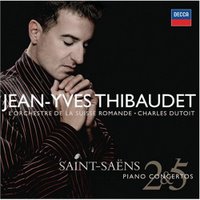 Jean-Yves Thibaudet, piano
Jean-Yves Thibaudet, pianol'Orchestre de la Suisse romande
Charles Dutoit, dir.
Decca 475 8764 (66 min 25 s)
**** $$$
Le jeu épidermique, plus brillant que profond, qui caractérise autant le chef Dutoit que le pianiste Thibaudet et qui convient à une certaine musique française de la seconde moitié du XIXe siècle, fait merveille dans le Deuxième et le Cinquième Concertos de Saint-Saëns. C'est un piano bondissant et cabriolant que l'on entend ici. Les difficultés dont sont parsemées les deux partitions sont surmontées avec un brio digital étonnant par Thibaudet, et l'Orchestre de la Suisse romande, fouetté par Dutoit, participe de la fête sonore. Le Deuxième Concerto, enlevé de bout en bout, et dont le troisième mouvement est particulièrement électrisant, convainc cependant plus que le Cinquième dont l'Andante semble un peu statique. Données en supplément et placées entre les deux compositions de Saint-Saëns, les Variations symphoniques de Franck ne trouvent pas l'atmosphère de recueillement nécessaire. Les phrasés gémissants du pianiste ne peuvent être tenus pour un signe de gravité et les quatre dernières minutes de l'oeuvre, aux temps beaucoup trop appuyés à l'orchestre, ressemblent à une faute de goût. Prise de son aérée et généreuse.
-Alexandre Lazaridès
Labels: french, product_review, saint-saens, thibaudet
Miklós Rózsa: Music for Violin and Piano
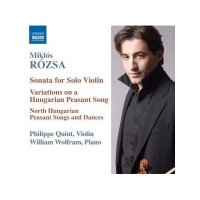
Philippe Quint, violon ; William Wolfram, piano
Naxos 8.570190
Il est regrettable que le nom du compositeur hongrois Miklós Rózsa ne soit resté célèbre que pour ses contributions au cinéma, que ce soit pour Ben Hur ou pour les films d'Hitchcock.
Il faut reconnaître à Naxos le mérite de permettre au grand public de (re)découvrir sa musique symphonique : Klaus Heymann produit ainsi en 2007 à la fois le Concerto et la Sinfonia Concertante pour violon, avec Anastacia Khitruk, et un fantastique album de pièces pour violon et piano.
Philippe Quint, accompagné par William Wolfram, donne à cet ensemble de pièces peu connues une dynamique et une chaleur exceptionnelles, que ce soit dans les oeuvres de jeunesse du compositeur, comme le Duo op. 7 de 1931, ou les Variations sur une chanson paysanne hongroise, op. 41, de 1929. On y retrouve l'influence du folklore d'Europe centrale, des mélodies hongroises, que Rózsa incorpore à son propre langage musical, hérité de ses maîtres Bartók et surtout Kodály. Philippe Quint tire de son Stradivarius ex-Kiesewietter une pureté de son dans les aigus et une chaleur dans les graves incomparables; afin d'exprimer pleinement le caractère « typique » de ces pièces, il a convoqué une articulation claire, rapide et précise, une technique parfaite de la main gauche et un jeu d'archet absolument stupéfiant, autant en dynamisme et qu'en phrasé. La preuve en est donnée dans les Chansons et danses des paysans du nord de la Hongrie, op. 5 : quelle énergie, quelle concentration, et quelle chaleur dans le jeu de Philippe Quint ! Il ne faudrait surtout pas sous-estimer le travail remarquable et l'accompagnement tout en nuances et en compréhension du formidable pianiste William Wolfram.
La « perle » de cet album, à recommander absolument et sans aucune réserve, demeure cependant la Sonate pour Violon seul, datant de 1986. Oeuvre de maturité, passant du rire aux larmes, de la sobriété au bonheur frénétique, elle trouve en Philippe Quint un interprète parfait : sûreté de l'intonation, pureté du son et de l'équilibre, au service d'une interprétation passionnée, convaincue et convaincante...Philippe Quint : retenez ce nom !
-Audrey Roncigli
Labels: french, product_review, quint, rozsa
Bach : Les suites pour violoncelle seul
 Jean-Guihen Queyras, sur violoncelle Gioffredo Cappa, 1696
Jean-Guihen Queyras, sur violoncelle Gioffredo Cappa, 1696Harmonia Mundi 901970.71
**** $$$$
Le violoncelliste Jean-Guihen Queyras a interprété les suites de Bach pendant vingt-neuf ans avant de les enregistrer. Il s'en est imprégné, elles sont devenues une part de lui et il nous les livre avec beaucoup d'enthousiasme et de vitalité. C'est avec une grande humilité devant l'oeuvre grandiose de Bach qu'il nous découvre son âme grâce aussi à son violoncelle Gioffredo Cappa de 1696, dans ce magnifique coffret de deux CD et un DVD.
Comme toujours chez Harmonia Mundi, nous avons ici un produit de grande qualité, autant par la perfection de l'enregistrement que la sobriété de la pochette et surtout la virtuosité de l'interprète, ce qui procure au mélomane un réel plaisir d'écoute.
Le visionnement du DVD de la suite numéro 3 est d'un égal bonheur, car il permet d'apprécier les qualités d'interprétation de Queyras et de vibrer avec lui dans cette même énergie qui se dégage de la musique de Bach.
-Francine Bélanger
Labels: bach, french, product_review, queyras
Donizetti: L'Elisir d'Amore
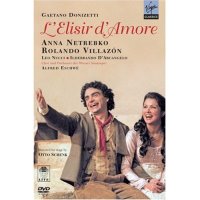 Chor und Orchester der Wiener Staatsoper; Alfred Eschwé, dir.
Chor und Orchester der Wiener Staatsoper; Alfred Eschwé, dir.Anna Netrebko, Rolando Villazón, Leo Nucci, Ildebrando D'Arcangelo
Otto Schenk, production, Karina Fibich, réalisation
Virgin Classics 00946 363352 9 (DVD: 130 min)
***** $$$$
Captée sur le vif en avril 2005, cette production de l'Élixir d'amour est enlevante dans l'ensemble, mais brille surtout par la présence du couple qui nous a déjà donné une inoubliable Traviata. Anna Netrebko incarne une Adina mutine et fraîche qui sait néanmoins, le moment venu, montrer la sincérité de ses sentiments amoureux. La voix est belle et le jeu toujours nuancé prouve qu'il s'agit là d'une véritable cantatrice. Rolando Villazón démontre des qualités de comique, mais peut-être en fait-il trop par moments sans y croire; la candeur de son Nemorino ressemble à la longue à de la stupidité; on s'étonne alors que l'intelligente Adina puisse s'éprendre d'un tel benêt de village. Le charlatan Dulcamara est rendu par un D'Arcangelo en grande forme : son duo endiablé du deuxième acte avec Adina est l'un des meilleurs moments de la production. Seul le vétéran Leo Nucci (Belcore) semble en retrait autant par la voix que par une interprétation quelque peu guindée malgré une présence scénique indéniable. Le décor réaliste et les costumes dans les teintes pastel évoquent une contrée lumineuse et sans drame; orchestre et chef sont à l'écoute des chanteurs. Une réserve : la prise de son est lointaine dans plusieurs solos, y compris Una furtiva lagrima que Villazón a dû bisser.
-Alexandre Lazaridès
Labels: donizetti, french, netrebko, product_review, villazon
Monday, January 21, 2008
Songs of Samuel Barber
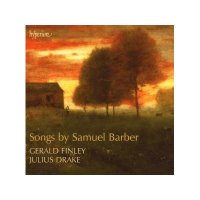 Gerald Finley, baritone; Julius Drake, piano; The Aronowitz Ensemble
Gerald Finley, baritone; Julius Drake, piano; The Aronowitz EnsembleHermit Songs, Op. 29; Mélodies passagères Op. 27; Dover Beach Op. 3; and others
Hyperion CDA67528
***** $$$$
Following the critically acclaimed disc of Charles Ives songs, baritone Gerald Finley and pianist Julius Drake teamed up for this album of Samuel Barber songs. It reaffirms their position as a great singer-pianist duo. Finley has a beautiful instrument, backed by solid technique, dramatic commitment, and superb musicianship. He is perfectly suited to these songs. A great melodist and unabashedly romantic, Barber's way with a melody bears a strong kinship to fellow American Ned Rorem, and to Giancarlo Menotti, with whom Barber had a lifelong professional and personal relationship. At a time when others rushed to serialism, Barber stuck to a lushly lyrical style deemed to be regressive and old-fashioned. It is thus ironic that his contemporaries, having flirted with atonality, reverted back to a more traditional style. Sadly, Barber, who died in 1981, didn't live long enough to witness the pendulum swinging back his way.
This disc contains 27 of Barber's best output, including Hermit Songs and Dover Beach, two of this three best song cycles. It's a pity that the third,
-Joseph K. So
Labels: barber, finley, product_review
Couperin : Pièces de clavecin
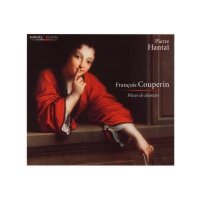
Pierre Hantaï, clavecin
Mirare MIR 027
65 min 49 s
****** $$$$
Applaudi pour ses interprétations de Bach et de Scarlatti, Pierre Hantaï n'avait à ce jour jamais enregistré de musique française en soliste. Il a néanmoins longtemps mûri ce répertoire, notamment en concert, si bien que le disque de François Couperin qu'il offre ici se classe d'emblée parmi les meilleurs. Le secret tient d'abord au choix de l'instrument : un clavecin lyonnais du dix-huitième siècle dont ne subsistait que la caisse et la table d'harmonie, et qui a repris vie récemment grâce à un travail poussé de restauration. Exploitant pleinement ce médium idéal, Pierre Hantaï nous mène de surprise en surprise, sans pourtant forcer le trait. Au contraire, il traite la partition avec sérieux et noblesse et c'est de cette lecture attentive que naît l'émotion. Derrière des titres un peu désuets, qui semblent annoncer de naïfs tableautins, se cachent en effet des pièces au climat souvent trouble : voyez l'élégance rêveuse de la Flore, l'extraordinaire nervosité de l'Anguille ou encore la poignante mélancolie des Vieux Seigneurs, sarabande grave dont les arpèges dissonants se réfugient avec nostalgie dans l'aigu. Pierre Hantaï refuse les intégrales, qui lui semblent fastidieuses, mais proposera semble-t-il un second florilège Couperin, qu'on attend avec joie.
-Philippe Gervais
Labels: couperin, french, hantaï, product_review
Carestini: The Story of a Castrato
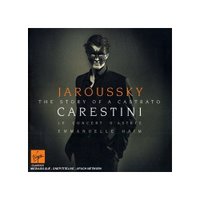
Philippe Jaroussky, haute-contre; Le Concert d'Astrée; Emmanuelle Haïm, dir.
Oeuvres de Porpora, Handel, Leo, Hasse, Gluck, Graun
Virgin 00946 3 95242 2 8
****** $$$$
Carestini fut un des castrats les plus appréciés de son temps, rivalisant avec Farinelli et parcourant l'Europe pendant près de trente ans, au service des meilleurs compositeurs. En vue de retracer la carrière de celui dont tous admiraient « les grandes et singulières dispositions », le haute-contre français Philippe Jaroussky a pensé offrir un choix de douze arias, inédits pour la plupart. À ses débuts, Carestini évoluait dans le registre de mezzo : l'Ariodante de Haendel, c'était lui, et bien que ce rôle soit aujourd'hui repris par des femmes, il ne pose aucune difficulté pour Jaroussky, doté d'aigus très faciles, comme on le voit aussi dans le brillant air de Porpora qui ouvre ce disque. Plus tard, la voix de Carestini se changea en un puissant contralto : c'est alors que Graun lui confia le rôle-titre de son Orfeo, oeuvre méconnue dont Jaroussky nous offre deux extraits, où il use avec beaucoup de goût de son registre de poitrine pour rendre les notes graves. L'orchestre du Concert d'Astrée pourra sembler ici un peu en retrait, mais qu'importe ! Philippe Jaroussky est un jeune chanteur comme il s'en trouve peu. Il est de ceux qui captent instantanément l'attention par leur audace et leur présence, et dont on sait déjà qu'on voudra collectionner tous les disques.
-Philippe Gervais
Labels: french, jaroussky, product_review
Bruckner 7
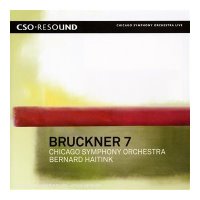 Chicago Symphony Orchestra; Bernard Haitink, dir.
Chicago Symphony Orchestra; Bernard Haitink, dir.CSO-Resound CSOR 901 706 (67 min 31 s)
***** $$$$
Au sommet de son art, Bernard Haitink livre ici une exécution imposante, d'une maîtrise toute en retenue, de la monumentale Septième Symphonie de Bruckner. La séparation des voix fait ressortir un travail de contrepoint généralement perdu ou sous-estimé ailleurs; cela ressemble par moments à de la musique de chambre, ce qui est inattendu quand il s'agit de l'orchestration si particulière du maître de Saint-Florian. Le premier mouvement est d'une ampleur pour ainsi dire liturgique; le chef prend le temps de respirer, et pourtant la ligne d'ensemble n'est jamais ignorée; la dynamique est constamment contenue, sans effets inutiles. Le deuxième mouvement souffre quelque peu de ce traitement élargi et paraît trop morcelé, même si le jeu demeure constamment beau. Dans le Scherzo, les célèbres cuivres de l'orchestre de Chicago s'en donnent à coeur joie, quoique leur exaltation, bien mise en relief par la prise de son, semble plutôt écrasante pour les cordes. Le dernier mouvement, dont la qualité d'écriture ne vaut pas les mouvements précédents, est traité en douceur et renoue avec l'atmosphère du premier mouvement. Une version qui mérite certainement l'attention des brucknériens.
- Alexandre Lazaridès
Labels: bruckner, chicago_symphony, french, product_review
Today's Musician Birthday: January 20
Labels: composer, theory birthdays
Sunday, January 20, 2008
Luisa Fernanda with Placido Domingo at the Movies
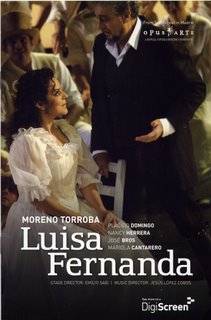
With the enormous success experienced by the Met, other opera companies are jumping on the bandwagon. The venerable La Scala showed its opening night Tristan und Isolde at selected movie houses in Europe and the US; Opera Australia and San Francisco Opera are also experimenting with non-satellite digital transmissions on a delayed basis. But so far none of these are coming to Canada - with one exception. Teatro Real of Madrid, an "A" house in Europe, has been showing its products through a partnership of Opus Arte and Digiscreen in the Empire Theatre chain and four independent repertory theatres in Canada with little fanfare. I knew nothing about it until my publisher called to see if I could write a review. A quick e-mail secured two media passes to yesterday's performance of Luisa Fernanda, a zarzuela starring megastar Placido Domingo. It was showing at the Empress Walk 10 of the Empire Theatres chain in North York. It is a short stroll north from the Sheppard Grande, where the Met has been showing its operas. Compared to the Sheppard Centre, Empress Walk is newer, better maintained, nicely designed with plenty of concession choices for those who want to grab a bite or a drink. The cinemas are immaculately maintained, and the staff offering friendly and efficient service. There was even a washroom attendant at the door - I give the theatre chain an "A" for effort!
Fearing it would be another sold out event, I decided to show up an hour early to secure a good seat. I needn't have worried. Shockingly, the single cinema showing the opera was practically deserted, even with Placido Domingo on the playbill. The Met experiment has demonstrated that there IS an audience for opera at the movies. True - fans are always attracted to a live event, and the Teatro Real productions are "canned". And zarzuela isn't a particularly big draw in Canada since we don't have a large Hispanic population. Still, if the product is good, the fans will come out. It is clear that Empire Theatres have a great deal of work to do in the publicity department. There was no mention of this in the local newspapers that I could find. I did an informal survey of my many opera friends. Except for the three friends that actually showed up yesterday, none of my other friends were aware of this event. But then, neither was I two days ago!
I have to admit my knowledge of zarzuelas is limited, except to say that it is Spanish and folksy, highly romantic, full of pretty tunes and colourful costumes. The story of Luisa Fernanda is your typical love triangle, with tuneul, rather uncomplicated harmonies and orchestration. The piece is also short - even with a 20 minute intermission, the show was over in about two hours. According to a friend who was recently in Madrid, "local" zarzuelas don't always have the best singers, but with the great Domingo in this show, you can't do better than this! Afterall, he sang as a kid in a zarzuela company in Mexico ran by his parents! As Vidal Fernando, Domingo sang with his trademark burnished tone. Despite looking a tad mature, he could still conjure up the image of an aging romantic hero, in the vein of a Don Quixote. Opposite him was the excellent Luisa of Nancy Fabiola Herrera. This Canarian-born, American-trained mezzo is currently at the Met singing Carmen. Rounding out the cast is Spanish tenor Jose Bros. A high tenor in the tradition of a Juan Diego Florez, Bros looked a bit young to be the Colonel Javier Moreno, but his clarion tenor was a pleasure. If the musical values were high, the production itself was strictly budget-wise. The battle scene was reduced to a few silhouettes projected onto the backdrop, and until the last act, the only props onstage were two dozen white chairs, and a tiny wooden model of the city of Madrid sitting on the side! A saving grace was the conducting of the highly experienced Jesus Lopez-Cobos. The picture quality in this HD moviecast is better than the Met's satellite transmission - no glitches and the sound is better. I spoke to almost everyone at the cinema, and they all enjoyed it. So it is a shame that so few people turned out. With more publicity, I am sure opera fans will show up. I think it is important for opera lovers to show up to these events, to show our support. When the next show is announced, I'll be sure to mention it in this blog. Stay tuned!
> More articles on HD Opera
Labels: Empire Theatres, HD, Luisa Fernanda, Opus Arte, Placido Domingo, Teatro Real Madrid
Saturday, January 19, 2008
Friday, January 18, 2008
Thursday, January 17, 2008
Wednesday, January 16, 2008
Today's Musician Birthday: January 16
Send musician's birthdays to mikevincent [at] scena.org
Tuesday, January 15, 2008
Canadian Opera Company's 2008-09 Season
Fall Season (Oct.) opens with Don Giovanni, with Brett Polegato in the title role. He sang the Don successfully two seasons ago for Vancouver. Also starring Robert Pomakov (Leporello), Jessica Muirhead (Anna), Julie Makerov (Elvira) Virginia Hatfield (Zerlina), Gordon Gietz (Ottavio). Very interesting casting, although I thought Makerov and Muirhead could switch roles. William Lacey conducts. This is paired with War and Peace. When I interviewed Richard Bradshaw in 2006, he told me the COC had already 'bought into' the ENO production but didn't have the money at the time to do it. This will be an important premiere. Russell Braun will be Prince Andrei - inspired casting! Lots of Russians in the cast. It is good to have Judith Forst back as Akhrosimova. No conductor announced.
Winter Season (Jan - Feb) will have Fidelio with Adrianne Pieczonka and Jon Villars as Leonore and Florestan. Also back are Gidon Saks and Mats Almgren. Great cast! Also of interest is the Canadian premiere of Rusalka, starring Julie Makerov and Michael Schade. No conductor announced. I seem to recall this was done in concert form before, but I am sure it is the staged premiere.
Spring Season (April - May) Simon Boccanegra, last done by COC in 1979. No Simon announced. Amelia is Serena Farnocchia, a role tailor-made for her. Also back are Mikhail Agafonov and Philip Ens. Boheme is back in a new production - finally we are rid of the old Wolfram Skalici production that necessitated 3 intermissions! The cast is almost all Canadians, with Frederique Vezina, David Pomeroy, Peter Barrett, and Robert Gleadow. The season ends with Britten's Midsummer Night's Dream, with countertenor Lawrence Zazzo as Oberon. I think Zazzo was engaged for Rodelinda before but cancelled. He is someone to look forward to. A strange bit of casting is Wolfgang Holzmair as Demetrius. Also featured are Giselle Allen and Robert Gleadow. Robert Pomakov as Bottom - also a rather unconventional choice!
I am sorry some names are missing - such as Michael Colvin, Isabel Bayrakdarian, and Ewa Podles - regulars and audience favourites from past seasons. Also, where is Gerald Finley, Measha Brueggergosman, and James Westman? it's about time we have these great Canadian singers, who are singing all over, on our own stages.
> Canadian Opera Company Website
> LSM Spotlight: Other 2008-09 Season Announcements
Labels: 2008-09_season, canadian_opera_company
Monday, January 14, 2008
Macbeth du Metropolitan Opera
Giuseppe Verdi : Macbeth
« Simulcast » du Metropolian Opera House de New York
Le samedi 12 janvier 2008, à 13 h 30
Distribution : Zelko Lucic (Macbeth), Maria Guleghina (Lady Macbeth), John Relyea (Banquo), Russell Thomas (Malcolm), Dimitri Pittas (Macduff), Elizabeth Blancke-Biggs (Dame de compagnie), James Courtney (Médecin).
Production conçue et mise en scène par Adrian Noble
Choeurs et orchestre du Metropolitan Opera House de New York dirigés par James Levine
***
Verdi, comme Shakespeare avant lui, a conçu Macbeth à la fois comme un drame privé (l'histoire d'un couple de criminels dévorés par le remords) et un drame politique (une histoire d'usurpation et de guerre civile). En transférant l'action du Moyen Âge au vingtième siècle, Adrian Noble a accentué la dimension politique. Il a ainsi rendu un fier service à la musique en faisant valoir les scènes de foule, notamment celles du quatrième acte, où le couple maudit n'apparaît pas et que l'on a donc souvent tendance à négliger. Par contre, lorsque certains détails de costume ou de décor attirent trop l'attention sur eux-mêmes - que l'on songe à l'attirail ridicule dont sont attifées les sorcières ou à la présence incongrue d'une jeep militaire dans le finale -, sa « vision », si imaginative soit-elle, tombe dans l'anecdotique et, ce faisant, cesse d'intéresser.
Par bonheur, les scènes centrées sur Macbeth et sa Lady ne souffrent pas de ce genre d'encombrement visuel. Elles se déroulent dans un espace sobre organisé autour de quatre grand piliers qui, selon le contexte, deviennent les arbres d'une forêt ou les colonnes d'une salle de château gothique. C'est dans cet espace, et autour d'un panneau qui parfois y descend, que les deux protagonistes peuvent se livrer en toute liberté à l'exploration de leurs rôles respectifs – des rôles difficiles, complexes et tourmentés, ainsi que nous le rappelait le Maestro Levine, un instant avant la représentation.
M. Lucic et Mme Guleghina forment le couple Macbeth idéal, lui retenu, elle déchaînée.
Depuis deux ou trois ans, Zaljko Lucic se multiplie sur les grandes scènes lyriques. Il ne chante à peu près que du Verdi, et aucun des grands rôles que ce dernier a écrits pour les barytons ne semble lui faire peur. Serait-il l'héritier, si longtemps attendu, du manteau des Tito Gobbi et des Leonard Warren ? Il est trop tôt pour l'affirmer. Sans doute a-t-il une très belle voix et un sens indéniable du drame, mais il n'a pas encore acquis cette personnalité distincte, cette sonorité tout à fait personnelle sans laquelle un artiste, si doué soit-il, ne peut vraiment prétendre au titre tant convoité de baryton Verdi.
Les opéraphiles sont très divisés au sujet de Mme Guleghina. Il est révélateur que ces divisions tendent à opposer ceux qui ne connaissent la diva ukrainienne que par le disque ou la radio et ceux qui l'ont à la fois vue et entendue, soit sur scène, soit sur DVD. Les premiers ne manquent pas de souligner les imperfections de sa technique et les multiples approximations qui affectent son approche du texte musical. Maria Guleghina est une interprète inégale qui a ses mauvais jours et, même ses meilleurs jours, des moments difficiles, y compris le samedi du simulcast. Ses admirateurs le savent, mais cela ne les empêche pas de rétorquer à ses critiques : Sans doute avez-vous raison, mais quelle bête de scène ! En effet, on ne saurait le nier : la Guleghina est une actrice née, une tragédienne extraordinaire dont l'art doit presque tout à l'instinct et peu à la réflexion ou à la méthode. Ses DVD, de plus en plus nombreux, témoignent de ce que, à son meilleur, son Abigaille, à Vienne, en 2001 (TDK,) peut être aussi impressionnante que sa Lady Macbeth, hier au Met ou en 2004 au Liceu (Opus Arte). Mais sa Madeleine de Coigny, à Bologne en 2006 (TDK) et plus encore sa Tosca à la Scala, en 2000 (TDK), ont de quoi laisser songeur...
Le problème de la Guleghina, à plus ou moins court terme, est que Verdi n'a pas écrit vingt rôles comme Abigaille et Lady Macbeth. Quoi d'autre pourrait-elle chanter pour continuer à progresser dans ce style intensément dramatique et quelque peu survolté qu'elle a choisi d'adopter ? Verdi, son compositeur fétiche, n'a pas grand-chose de plus à lui offrir dans cette veine. Le belcanto est évidemment exclu (quoiqu'elle ait tout récemment tenté de s'attaquer à Norma). Le vérisme ? Ce n'est pas évident. Puccini ? On pourrait (peut-être) l'imaginer en Turandot, mais il n'y a qu'à l'écouter chanter « Vissi d'arte » pour douter qu'elle ait la subtilité et la finesse qu'exigent la plupart des autres emplois de sopranos pucciniens. Peut-être espère-t-elle finir, comme Rysanek, chez Strauss et Wagner, auquel cas il faudrait qu'elle solidifie sa technique pour mieux discipliner sa voix.
Entre-temps, son interprétation très personnelle du rôle de Lady Macbeth, « toute d'une pièce », demeure un spectacle sonore et visuel qui mérite d'être préservé pour la postérité. On espère que le Met aura la bonne idée d'en tirer un DVD.
Du reste de la distribution, il n'y a que du bien à dire. John Relyea et Russell Thomas se sont, comme toujours, montrés excellents dans leurs rôles de soutien, de même que très appréciés du public new-yorkais. Quant au ténor Dimitri Pittas, un nouveau venu, il a immédiatement séduit : on ne demande qu'à l'entendre à nouveau, alors même qu'on s'interroge sur ce qui a pu arracher une larme à son oeil gauche (en gros plan !) à la fin de sa grande scène. Un tendre et profond sentiment ou... un morceau d'oignon ?
Côté jardin et côté cour, on a pu constater que ce n'était pas pour rien qu'Adrian Noble a présidé pendant près de quinze ans aux destinées de la Royal Shakespeare Company : il sait comment transformer une masse amorphe de choristes et de figurants en un véritable acteur collectif.
Enfin, à l'orchestre, on continue de s'émerveiller des ressources que James Levine peut tirer d'un ensemble qu'il a lui-même dans une large mesure recréé depuis les nombreuses années qu'il le dirige.
Le prochain simulcast du Met aura lieu le 16 février. On présentera alors Manon Lescaut de Puccini.
Labels: HD, Maria Guleghina, Metropolitan Opera, opera
Today's Musician Birthday: January 14

1956 - Ben Heppner, tenor
> Official Website
Canadian tenor Ben Heppner sings "Morgenlich Leuchtend Im Rosigen Schein" (Walther's Prize Song) from Richard Wagner's Die Meistersinger von Nürnberg at the gala honoring the retirement of Met General Manager Joseph Volpe, May 20, 2006.
_
Labels: Ben Heppner, birthdays, composer, opera
Sunday, January 13, 2008
Today's Musician Birthday: January 13
1973 - Juan Diego Florez, tenor
> Official Website
> Wiki Entry
Here is a video clip of Florez singing the aria "Ah Ritrovarlo Io Giuro" from Rossini's La Cenerentola just last week.
Notify us of other musician birthdays: wkchan [at] scena.org
Labels: birthdays, Juan Diego Florez, opera
Met Opera at the Movies: Macbeth
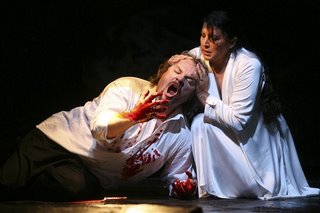 Last October, the Met unveiled a new production of Verdi's Macbeth to rather mixed reviews. Audience and critics praised the strong musical values, but the modern production didn't sit well with the more tradition-bound segment of the Met audience. Yesterday, the Met at the Movies audience got to decide for themselves. Once again, I saw the show at Sheppard Grande. I am not sure if everything was sold out, but the crowd appeared to be larger than the New Year's Day Hansel und Gretel. As a bonus, the new concessions with a more upscale menu opened just in time for the occasion. Judging by the huge line, it was more appealing to the mature opera audience than pop corn and soft drinks.
Last October, the Met unveiled a new production of Verdi's Macbeth to rather mixed reviews. Audience and critics praised the strong musical values, but the modern production didn't sit well with the more tradition-bound segment of the Met audience. Yesterday, the Met at the Movies audience got to decide for themselves. Once again, I saw the show at Sheppard Grande. I am not sure if everything was sold out, but the crowd appeared to be larger than the New Year's Day Hansel und Gretel. As a bonus, the new concessions with a more upscale menu opened just in time for the occasion. Judging by the huge line, it was more appealing to the mature opera audience than pop corn and soft drinks.One of Verdi's early successes, Macbeth had its premiere in 1847, later revised by the composer in 1865. It is the revised version that is most often heard today. Macbeth is not staged all that frequently today because there simply aren't too many singers who can do it justice. The Met is fortunate to have the services of Russian soprano Maria Guleghina, arguably the reigning Verdian dramatic soprano, as Lady Macbeth. I first heard her in the killer role of Abigaille at the Lyric Opera of Chicago in the 1997-8 season. Now ten years later, she is still on top of her game, a remarkable testament of vocal longevity in this punishing repertoire. She is partnered by Serbian baritone Zeljko Lucic, a voice new to me, in the title role. (Italian Lado Ataneli and American Andrea Gruber take over the roles later on in the season)
To the more superstitiously minded, Macbeth is supposed to be cursed. Historically revivals of this opera were reputedly plagued by back luck, accidents, or assorted unexplained happenings. I remember vividly tuning into a Met broadcast of Macbeth around 1986. The second intermission seemed inordinately long. Just when I was wondering what was going on, the announcer Peter Allen said to the radio audience that there had been some sort of accident in the house, but he didn't elaborate, except to say that the singers were fine. I was looking forward to hearing Elizabeth Connell in her Sleeping Walking Scene, but it was not to be. There was no Act Four as the rest of the performance was cancelled. Later I heard that someone in the audience jumped from the balcony to his death.
Thankfully nothing that dramatic happened at the Met yesterday - at least all the drama remained on stage! Top vocal honours went to Maria Guleghina as a fearless Lady Macbeth. She threw herself into the role, giving a vocally and dramatically riveting performance. Her steely soprano certainly had the power and range, and she was in searing voice. She nailed her first two arias - "Vieni t'affretta" and "La luce langue" - as if it was child's play, combining ample dramatic weight with thrilling highnotes. Singing with such vocal force and acting with a surfeit of physical energy, a certain toll was perhaps inevitable. In the later acts, some of her high notes in the ensembles were flat. She tired noticeably by the Sleepwalking Scene - her high D-flat was probably a note she wished she could have back. But the audience loved her anyway and gave her a well deserved ovation at the end.
Given such a powerhouse Lady Macbeth, Zeljko Lucic (MCBETH) was somewhat over-shadowed. But the Serbian was an true Verdi baritone, with a pleasing timbre and a secure top register. He probably got carried away by the heat of the moment and didn't pace himself, tiring and turning raspy and strained at the very end. Canadian bass John Relyea, a stalwart at the Met the last few seasons, was a terrific Banquo. As Macduff, tenor Dimitri Pittas sang with strong, clarion tone. I think Pittas is a student of Bill Neill and the late Dixie Ross Neill. I heard his Rodolfo in a Santa Fe Opera La boheme last summer and was blown away. I would have liked a bit more mezza voce from him, but it is hard to argue with such a great voice.
Now the production. This show demonstrates that even the august, tradition-bound Met is slowly changing. Even a few short season ago, a modern dress production like this one would have been grudgingly accepted in something "far-out" like Lady Macbeth of Mtsensk, but it would have been unthinkable in Verdi's Macbeth. To be sure, by Regietheater standards, this Macbeth is really quite mild. Adrian Noble's direction was eccentric but not offensive, and the audience seemed to have accepted it judging by the reaction at the end. The videographic work - all 12 cameras worth - was wonderful as usual. However, I am beginning to think this is a bit of a double-edged sword. Unlike a Romeo et Juliette production populated by beautiful people the likes of Netrebko and Alagna, the extreme closeups of the less photogenic Madame Guleghina straining for a high note didn't have quite the same audience appeal... The Act Three Witches' Gathering would have looked great from the far reaches of the Met auditorium, but the closeups of children repeatedly retching and vomiting into the silver chalice was, shall I say, more than we bargained for. All kidding aside, the best thing about the videography is the scene changes, giving the uninitiated a real taste of the enormous effort it takes to put on a show like this. The musical side of things got a boost from a newly rejuvenated James Levine, leading the superb Met orchestra and chorus in a vital reading of the score. He seems to have recovered from his various ailments the last two seasons, and the orchestra responded beautifully. And I must say the women's choristers, long the Achilles heel of the Met Chorus, is finally sounding less superannuated. I say, bring on Manon Lescaut!
Labels: Macbeth, Maria Guleghina, Metropolitan Opera, opera
Friday, January 11, 2008
Today's Musician Birthday: January 11
Thursday, January 10, 2008
Joan Ingpen - Lest she be forgotten
Joan Ingpen, whose death is reported here, was the one and onlie true begetter of the Big Lucy machine, as well as being the unseen force behind Georg Solti. A full account can be found in my book, Covent Garden:The Untold Story, and one of the joys of its research was getting to know Joan over several lunches in Marylebone. She was, by then, well into her 70s, but the memory was sharp as a pin and the tolerance for sloppiness was zero.
Pavarotti was always a bit scared of her, and Solti untypically deferential. She gave as good as she got and never knowingly foisted a dud artist on the innocent public. Now of how many concert agents and casting managers can that be said?
Source: Arts Journal
Labels: administration
Today's Musician Birthday: January 10
Born on January 10:
1961 - Nadja Salerno-Sonnenberg, violinist
> Official Website
Here is a video clip of her playing the Tchaikovsky Concerto at her Carnegie Hall debut in 1983.
Let us know what you think.
Wednesday, January 9, 2008
Profits in the Classical Music Recording Industry
Operating exclusively online, ArkivMusic's advantage is its "endless shelf" of available classical CD inventory. The company is an example of The Long Tail theory where companies profit by selling less of more. Classical aficionados can access the largest number of classical recordings available anywhere in the world -- over 82,000 titles -- including nearly 5,000 formerly out-of-print titles produced "on demand" as ArkivCDs.Just a couple of weeks ago, Naxos founder Klaus Heymann revealed in an interview with Stereophile that the company was profitable, especially with their digital strategy.
"The ArkivCD program made up about 10% of our overall business in the fourth quarter," continued Feidner. "That's a significant percentage for what is essentially a new line of products. We launched this initiative late in 2006, and we continue to reissue hundreds of releases each month as we expand the catalog of formerly deleted titles."
When I started, all I was trying to do was sell a CD at the price of an LP. It was a marketing idea for the Hong Kong and Southeast Asian markets. I never imagined we'd become a powerhouse, with 300 employees worldwide, and 60 programmers and systems analysts in our Information Technology department. We're the only record company in the world with our own digital platforms. We have our own download and streaming sites, handle digital distribution for some of the labels we distribute physically, and also have books, audio books, and educational materials.The moral of the story is that there are always winners and losers in any industry. While the major labels and retailers were downsizing, specialized companies can turn a profit.
For me, being in classical music has always been a lifestyle decision. For years, we didn't make any money. I've invested an enormous amount of money--$80 million US--in the entire catalog and range of products, and never had a normal return until, thanks to the advent of digital platforms, I made a decent return last year. I'm extremely happy. I'm doing what I love, and I'll finally make some money from it.
Labels: CDs, Recordings
Sunday, January 6, 2008
Rolando Villazon Makes Successful Return to the Opera Stage
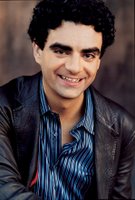 The opera community breathed a sign of relief last night (January 5, 2008). Star Mexican tenor Rolando Villazon made a triumphant and successful return to the operatic stage at the Vienna State Opera in Massenet's Werther. According to Associated Press's review, the audience started clapping right from the start and gave him an extended ovation at the end.
The opera community breathed a sign of relief last night (January 5, 2008). Star Mexican tenor Rolando Villazon made a triumphant and successful return to the operatic stage at the Vienna State Opera in Massenet's Werther. According to Associated Press's review, the audience started clapping right from the start and gave him an extended ovation at the end.Villazon is considered a leading heir to the "Three Tenors" but took 6 months off from singing, leading to speculations that he was suffering from vocal trouble.His return Saturday set the stage for huge expectations that were mostly -- but not completely -- met.
While wonderfully supple -- and surprisingly strong at times -- Villazon's voice was occasionally lost in the more powerful orchestral passages -- and it wasn't the fault of conductor Marco Armiliato.
Although he appeared to be hitting his high B's, it wasn't always apparent -- because when trying too hard to be heard, Villazon's lyric tenor just seemed to top out among all those potent brass passages of the second and third acts.
Villazon himself appeared to be less than completely satisfied. Miguel Perez, who described himself as a friend of Villazon from Barcelona, said the tenor told him between breaks that he was "very happy" with the first act but "not very happy with the second."
On the web:
Friday, January 4, 2008
Seattle Opera to Present Robert Lepage's Staging of Erwartung and Bluebeard's Castle
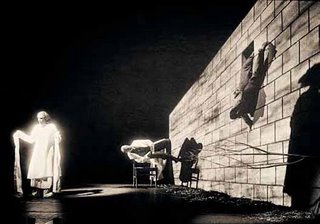 Seattle Opera's 2008-09 Season will feature Robert Lepage's staging of Bartók's Bluebeard's Castle and Schoenberg's Erwartung, the double-bill he first premiered with the Canadian Opera Company in 1992. This production pairing is turning out to be in high demand as a rental. The Montreal Opera already presented this production in April 2004 and the Opéra de Québec has scheduled it in October 2008 to close out Quebec City's 400th anniversary. Seattle Opera's offering in February and March 2009 is the latest.
Seattle Opera's 2008-09 Season will feature Robert Lepage's staging of Bartók's Bluebeard's Castle and Schoenberg's Erwartung, the double-bill he first premiered with the Canadian Opera Company in 1992. This production pairing is turning out to be in high demand as a rental. The Montreal Opera already presented this production in April 2004 and the Opéra de Québec has scheduled it in October 2008 to close out Quebec City's 400th anniversary. Seattle Opera's offering in February and March 2009 is the latest.See the Seattle Opera press release.
On the web:
New Approach to Popular Free Events - First Come First Serve
CBC Radio One will broadcast the concert live at 4 p.m. while Radio Two will rebroadcast it at 8 p.m. Performers will include Sharon Riley & Faith Chorale, the Nathaniel Dett Chorale, and the University of Toronto Gospel Choir, as well as Measha Brueggergosman.It's a strategic decision meant to avoid the negative consequences of ticketed free events.
For example, many of those who lined up for free tickets to the Richard Bradshaw tribute at the Four Seasons Centre for the Performing Arts did not turn up for the concert. The result: empty seats, despite the fact there were thousands of disappointed opera lovers who couldn't get tickets.
Another pitfall became apparent at the Lincoln Center memorial event for Beverly Sills, the queen of New York opera. The lineup for tickets started at 5:30 a.m. Even though they were free, scalpers had a good day pocketing money from fans who arrived after all the tickets had been given away.
There are approximately 2,500 seats at Roy Thomson Hall. About 200 will be reserved for VIP guests. It's open season on the other 2,300 seats.
Labels: jazz, memorial concert
Wednesday, January 2, 2008
Met at the Movies: Hansel and Gretel
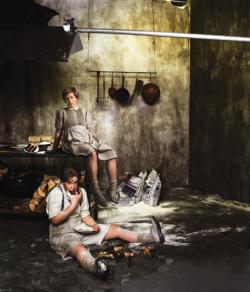 The second installment of the current Met in HD arrived on New Year's Day. It happened to coincide with a fierce snowstorm that descended on Toronto just hours earlier. But you would never have guessed looking at the huge turnout at the Sheppard Grande in Toronto. Perhaps there was one surprise - the audience demographics remained as superannuated as ever. I spotted all of six children the whole afternoon! Despite the bad weather that can sometimes affect reception, the performance in Cinema Three went smoothly. There was only, literally, a split-second loss of sound, which the theatre manager assured me was the fault of the Met. He also said he personally went up to the theatre roof before the show to make sure the satellite dish was free of snow...
The second installment of the current Met in HD arrived on New Year's Day. It happened to coincide with a fierce snowstorm that descended on Toronto just hours earlier. But you would never have guessed looking at the huge turnout at the Sheppard Grande in Toronto. Perhaps there was one surprise - the audience demographics remained as superannuated as ever. I spotted all of six children the whole afternoon! Despite the bad weather that can sometimes affect reception, the performance in Cinema Three went smoothly. There was only, literally, a split-second loss of sound, which the theatre manager assured me was the fault of the Met. He also said he personally went up to the theatre roof before the show to make sure the satellite dish was free of snow...Labels: HD, Metropolitan Opera










